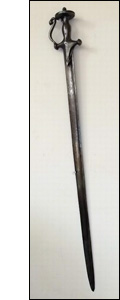featured item

quality pair of antique edwardian postal scales and weights Read more
Antique Swords
Posted by Gill Jones on 23/08/2013
 Swords can tell a story, one of heroism or cowardice, action or inaction, fighting to the death, or defending one’s honour. Swords are collectors pieces and naturally, like most antiques, the older they are the more they are worth. Japanese swords are particularly popular and these are without doubt swords with a long and noble history. Although the most popular Japanese swords are those from the Second World War period, they go back many centuries.
Swords can tell a story, one of heroism or cowardice, action or inaction, fighting to the death, or defending one’s honour. Swords are collectors pieces and naturally, like most antiques, the older they are the more they are worth. Japanese swords are particularly popular and these are without doubt swords with a long and noble history. Although the most popular Japanese swords are those from the Second World War period, they go back many centuries.
In fact, swords go back across Japan’s entire historical period with sword making becoming more and more sophisticated as time wore on. Some of the earliest weapons go as far back as 2000 BC, which were normally imported from Korea or China, where they first appeared. Japanese sword makers would begin making theirs around 700 AD and would become some of the finest swords ever made.
Amakuni was particularly famous for his sword making skills and responded to an increase in demand as constant conflicts over land frequently erupted and battles raged against invaders. When they weren’t holding off potential invaders they were fighting other countries so it’s easy to see where the demand for a more sophisticated fighting sword came from. And it wasn’t just Amakuni that was in demand; others skilled in the art of sword making were sought out all over Japan.
Japanese swords started out as long swords and went through 3 manifestations, the earliest being the “chokuto,” meaning straight sword. This type of sword would often give the fighter more leverage and he could hold it easily in one hand. Shapes changed over time the “tachi” would be a long sword of nearly 4ft in length and was good for those fighting on horseback. Later, as warriors fought on foot, this type of sword was too difficult to wield. A shorter version was developed known as the “katana” it was between 2ft and 4ft long and could be used far more efficiently and quickly.
The katana was also used during the Second World War and these are some of the most famous and most in demand swords from this period. They were often heirlooms and passed down from one generation to another. The Shin Gunto is another type of sword from the Second World War period. During this time swords were often machine made rather than hand made to meet increasing demand. Some however, were still made by hand, but not by traditional Japanese methods, these would be swords such as Showato, Muratato, Mantetsuto, Hantanza or Yotetsuto.
There are some interesting swords on www.antiques.co.uk with some from the 18th century and mainly from the Second World War period. Firstly, we have the Second World War katana. It’s in fabulous condition with a beautifully made handle and the familiar curved blade. Another katana comes with a highly polished blade and a slightly shorter tang from previous mounts, but again is in near perfect condition. There’s an extremely beautiful Wakizashi sword, which means it’s a “side inserted sword”, meaning a sword worn at the side of the body. They were used as far back as the 16th century and were used for fighting up close and also to behead an opponent. It was a short sword. This one is signed by its original owner on the handle. There are at least two swords from the 18th century and all are in excellent condition. It’s definitely worth taking a look, because with their fascinating and turbulent history Japanese swords are the by far the most interesting of fighting weapons.



